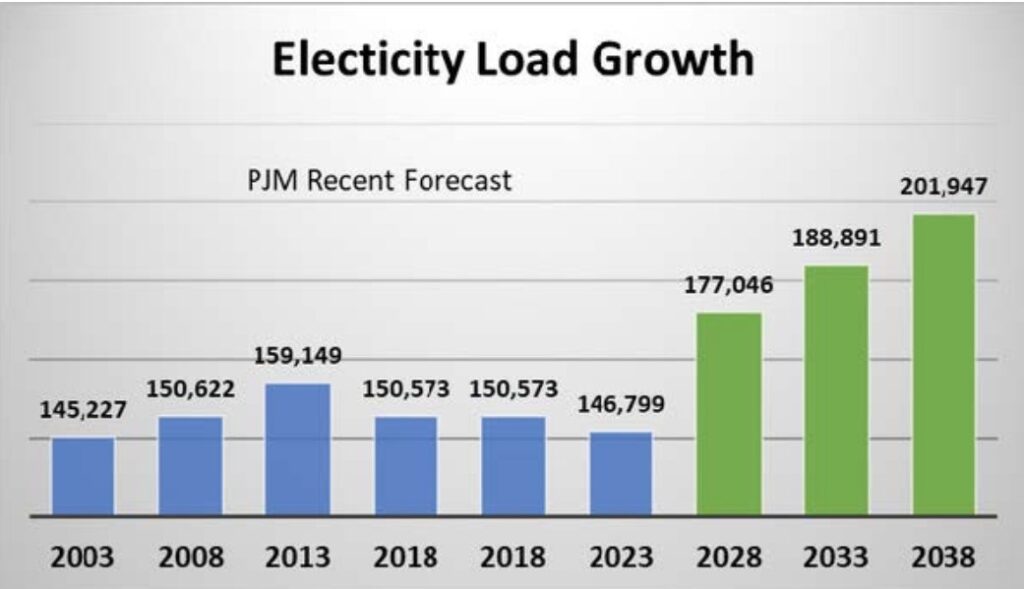US is facing risk of rolling blackouts as predicted electricity demand DOUBLES with AI data centers and crypto mines presenting ‘staggering challenge’ to the outdated grid
- Innovations in artificial intelligence, cloud computing and crypto mining are driving demand for power up
- The already ailing national grid is ill-equipped to deal with the increased demand with demand projections doubling this year

Swaths of the US are at risk of power outages with artificial intelligence data centers and cryptocurrency mines doubling forecasted energy demand over the coming years.
Without intervention, the already ailing national grid will be pushed to its limits by skyrocketing demand, driven by rapid innovations in AI, cryptocurrencies and clean energy initiatives all of which require vast amounts of power.
Projections for electricity demand over the next nine years have more than doubled from 221,000 gigawatt hours last year to 564,000 gigawatt hours this year, according to the North American Electric Reliability Corp.
Jason Shaw, chairman of the Georgia Public Service Commission, which regulates electricity, told the Washington Post the numbers are ‘staggering’.
He said: ‘It makes you scratch your head and wonder how we ended up in this situation. How were the projections that far off? This has created a challenge like we have never seen before.’
The rise is being driven largely by developments in AI, cloud computing and cryptocurrency mining all of which require large data centers which in turn consume vast amounts of power.
The International Energy Agency (IEA) predicts that globally ‘electricity consumption from data centres, artificial intelligence (AI) and the cryptocurrency sector could double by 2026.’
By 2026, they say global data centers’ energy demand will equal that of the entirety of Japan.
There are currently an estimated 2,700 data centers within the US according to the IEA, which sapped over four percent of the nation’s electricity in 2022.
They predict that by 2026, their consumption will rise to six percent.
Some firms are turning to their own forms of power generation to power their centers, in an attempt to avoid the long waits and unreliable supply from the grid.
Microsoft and Google are both hoping they will eventually be able to power their operations with small nuclear plants onsite meaning they will not have to rely so heavily on the national grid.
The manufacturing of ‘clean power’ products like solar panels and electric car batteries is also driving demand, requiring new factories and hook-ups to the grid.
Demand outstripping supply will likely lead to shortages across the country, with some areas worse hit than others.
The North American Electric Reliability Corporation (NERC) has made a risk map in its Long term reliability assessment.

They said: ‘The North American BPS is on the cusp of large-scale growth, bringing reliability challenges and opportunities to a grid that was already amid unprecedented change.’
Broken down by regional electricity provider, NERC predicts areas covered by MISO and SERC will be worst hit.
They define high risk as meaning ‘the supply of electricity for these areas is more likely to be insufficient in the forecast period and that more firm resources are needed.’
The high risk areas cover parts of Arkansas, Illinois, Indiana, Iowa, Kentucky, Louisiana, Michigan, Minnesota, Mississippi, Missouri, Montana, North Dakota, South Dakota, Texas, and Wisconsin.
Meanwhile the West of the country is at ‘elevated risk’ of shortages over the next four years.
NERC said that while these areas may be able to cope with demand in normal weather conditions they may struggle with ‘extreme heat and subfreezing’ temperatures.
With rates of extreme weather events increasing across the US NERC says the risk of shortfalls is heightened.
Generators are often not designed or prepared for extreme temperatures and can be forced offline while severe weather can damage infrastructure, impacting energy production and transportation.
Demand is also higher with air conditioning and heating.
NERC says energy providers need to add more reliable resources to meet the risks, and expand their networks to deliver power to new locations and factories.
Andy Cvengros, managing director of data center markets at JLL, a commercial real estate firm that services the tech industry told The Post: ‘Across the board, we are seeing power companies say, “We don’t know if we can handle this; we have to audit our system; we’ve never dealt with this kind of influx before”.
‘Everyone is now chasing power. They are willing to look everywhere for it.’
